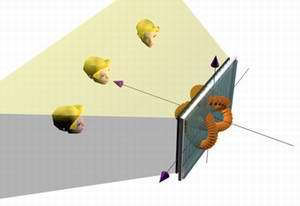3D Scalable Integrated Displays

Until now 3D displays have been developed for only one viewer. Christian Moller a research student here at the Department is working on a 3D display where the viewing zone is equal to that of any television allowing an unlimited number of people to view at any one time. The display is very easy to scale and is flat panel. Part of the success of this new display is being able to use the Wedge technology developed by Dr Adrian Travis here at the Department to make this display flat panel.
The technology produces a holographic experience and has a combination of properties that make it unique:
-- True 3D, you can look around objects by moving the head sideways
-- No restriction in head movement or number of viewers
-- Full colour and full resolution
-- Flat panel
-- No headgear or head tracking equipment
This £1.5m applied research project is developing the building blocks for a 3D digital display system that can be applied to a wide range of the most demanding applications in visualisation, simulation, cinema and entertainment. The collaborators include two of the UK's leading companies in digital projection and image processing working together with the Department of Engineering.
The results of this project could give the UK new access to markets for visualisation technology, active 3D cinematic display and a range of specialist scientific applications. Setred has been set up as a spin-out company, in order to commercialise this ground-breaking research. Setred was set up as a result of the Cambridge University Entrepreneurs £50K Business Creation Competition.

Source: Cambridge University















